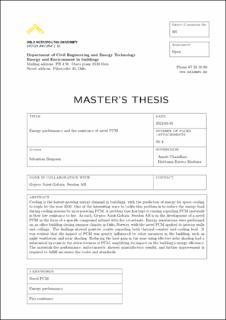| dc.description.abstract | Cooling is the fastest-growing energy demand in buildings, with the prediction of energy for space cooling
to triple by the year 2050. One of the interesting ways to tackle this problem is to reduce the energy load
during cooling seasons by incorporating PCM. A problem that has kept occurring regarding PCM materials
is their low resistance to fire. As such, Gyproc Saint-Gobain, Sweden AB is in the development of a novel PCM
in the form of a spackle compound infused with fire retardants. Energy simulations were performed on
an office building during summer climate in Oslo, Norway, with the novel PCM applied to interior walls
and ceilings. The findings showed positive results regarding both thermal comfort and cooling load. It
was evident that the impact of PCM was greatly influenced by other measures in the building, such as
night ventilation and solar shading. Reducing the heat gain in the zone using effective solar shading had a
substantial increase in the attractiveness of PCM, amplifying its impact on the building's energy efficiency.
The materials fire performance, unfortunately, showed unsatisfactory results, and further improvement is
required to fulfill necessary fire codes and standards. | en_US |
